MANM4000 Introduction to Management: D7 Displays Case Study Solution
VerifiedAdded on 2023/06/15
|10
|1979
|251
Case Study
AI Summary
This case study solution analyzes the management and leadership challenges at D7 Displays, focusing on the conflict between Tom Green and Frank Davis. It identifies issues such as ineffective leadership, communication gaps, and lack of motivation. The solution explores various motivation theories like Maslow's hierarchy of needs and McGregor's X and Y theory, and applies human resource models such as goal-setting and expectancy theory to improve organizational performance. Furthermore, it suggests the application of participative and transformational leadership theories to resolve the conflict and enhance decision-making within the company. The document is available on Desklib, a platform offering a wealth of study resources for students.
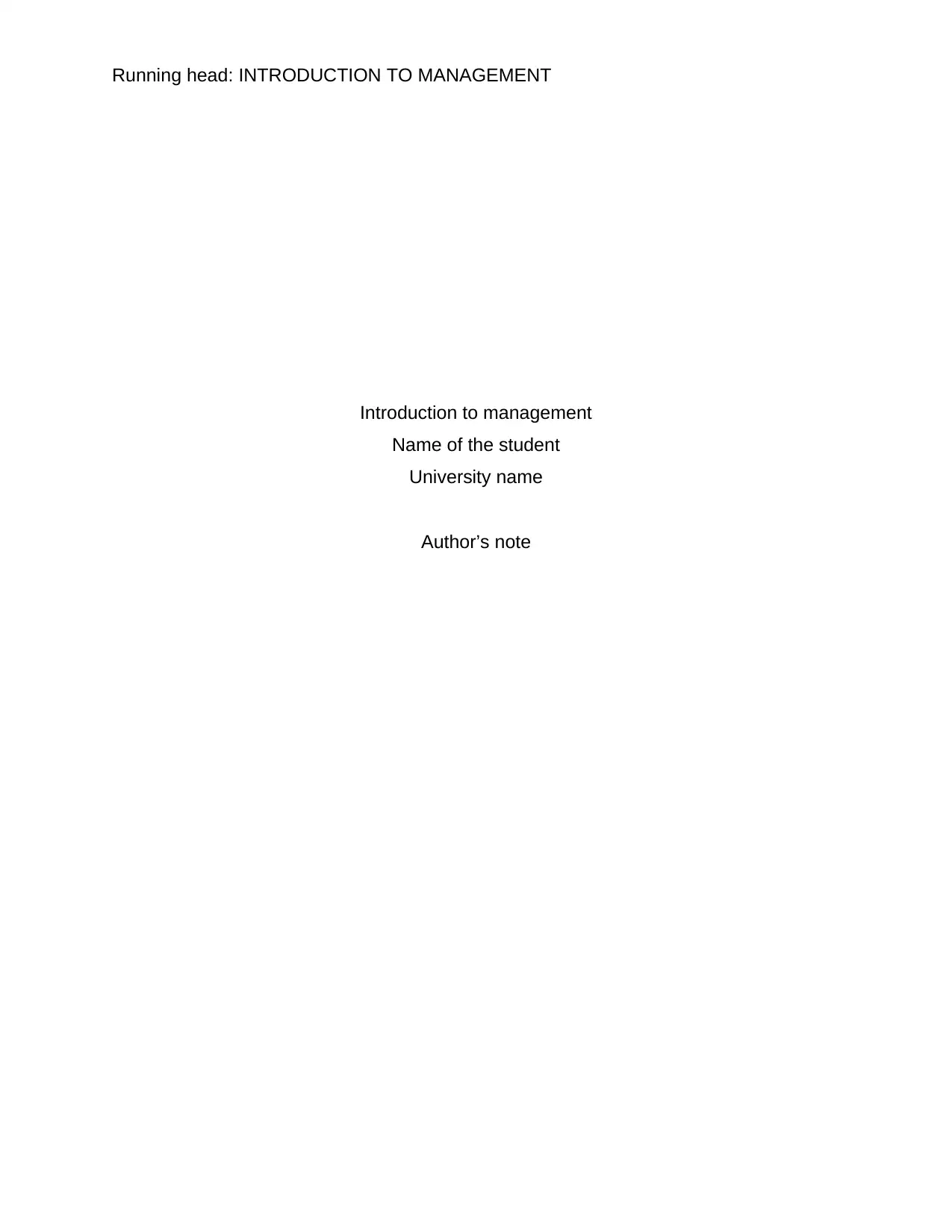
Running head: INTRODUCTION TO MANAGEMENT
Introduction to management
Name of the student
University name
Author’s note
Introduction to management
Name of the student
University name
Author’s note
Paraphrase This Document
Need a fresh take? Get an instant paraphrase of this document with our AI Paraphraser
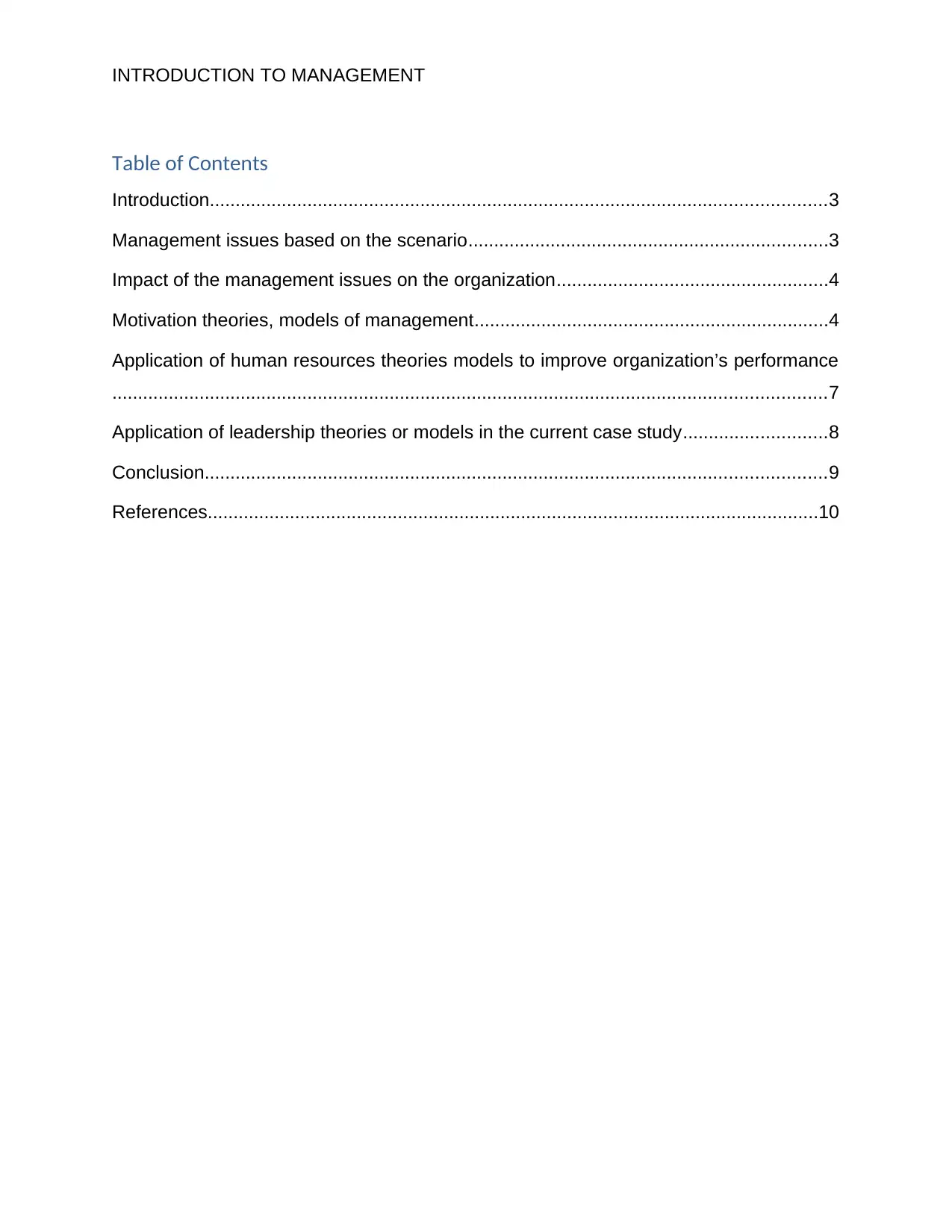
INTRODUCTION TO MANAGEMENT
Table of Contents
Introduction........................................................................................................................3
Management issues based on the scenario......................................................................3
Impact of the management issues on the organization.....................................................4
Motivation theories, models of management.....................................................................4
Application of human resources theories models to improve organization’s performance
...........................................................................................................................................7
Application of leadership theories or models in the current case study............................8
Conclusion.........................................................................................................................9
References.......................................................................................................................10
Table of Contents
Introduction........................................................................................................................3
Management issues based on the scenario......................................................................3
Impact of the management issues on the organization.....................................................4
Motivation theories, models of management.....................................................................4
Application of human resources theories models to improve organization’s performance
...........................................................................................................................................7
Application of leadership theories or models in the current case study............................8
Conclusion.........................................................................................................................9
References.......................................................................................................................10
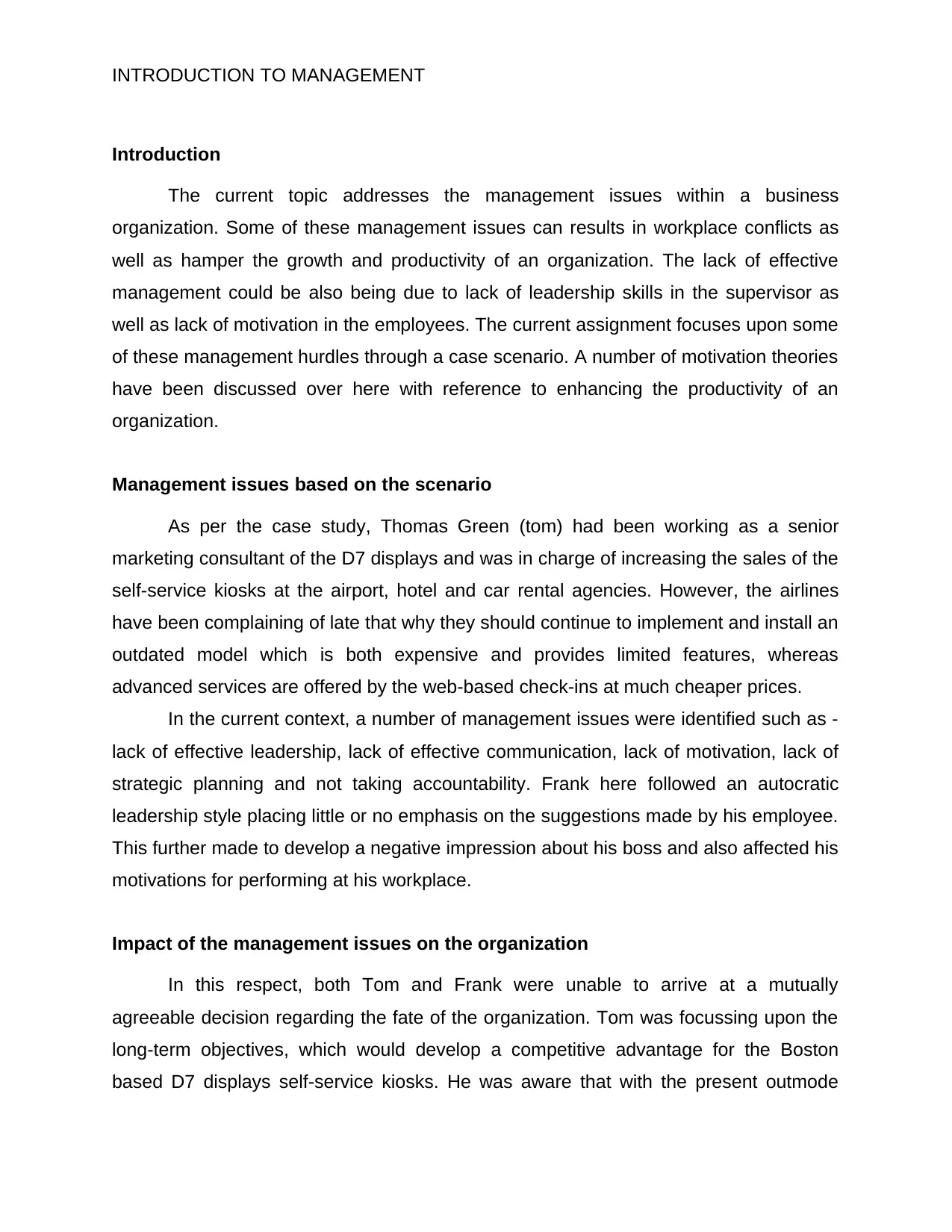
INTRODUCTION TO MANAGEMENT
Introduction
The current topic addresses the management issues within a business
organization. Some of these management issues can results in workplace conflicts as
well as hamper the growth and productivity of an organization. The lack of effective
management could be also being due to lack of leadership skills in the supervisor as
well as lack of motivation in the employees. The current assignment focuses upon some
of these management hurdles through a case scenario. A number of motivation theories
have been discussed over here with reference to enhancing the productivity of an
organization.
Management issues based on the scenario
As per the case study, Thomas Green (tom) had been working as a senior
marketing consultant of the D7 displays and was in charge of increasing the sales of the
self-service kiosks at the airport, hotel and car rental agencies. However, the airlines
have been complaining of late that why they should continue to implement and install an
outdated model which is both expensive and provides limited features, whereas
advanced services are offered by the web-based check-ins at much cheaper prices.
In the current context, a number of management issues were identified such as -
lack of effective leadership, lack of effective communication, lack of motivation, lack of
strategic planning and not taking accountability. Frank here followed an autocratic
leadership style placing little or no emphasis on the suggestions made by his employee.
This further made to develop a negative impression about his boss and also affected his
motivations for performing at his workplace.
Impact of the management issues on the organization
In this respect, both Tom and Frank were unable to arrive at a mutually
agreeable decision regarding the fate of the organization. Tom was focussing upon the
long-term objectives, which would develop a competitive advantage for the Boston
based D7 displays self-service kiosks. He was aware that with the present outmode
Introduction
The current topic addresses the management issues within a business
organization. Some of these management issues can results in workplace conflicts as
well as hamper the growth and productivity of an organization. The lack of effective
management could be also being due to lack of leadership skills in the supervisor as
well as lack of motivation in the employees. The current assignment focuses upon some
of these management hurdles through a case scenario. A number of motivation theories
have been discussed over here with reference to enhancing the productivity of an
organization.
Management issues based on the scenario
As per the case study, Thomas Green (tom) had been working as a senior
marketing consultant of the D7 displays and was in charge of increasing the sales of the
self-service kiosks at the airport, hotel and car rental agencies. However, the airlines
have been complaining of late that why they should continue to implement and install an
outdated model which is both expensive and provides limited features, whereas
advanced services are offered by the web-based check-ins at much cheaper prices.
In the current context, a number of management issues were identified such as -
lack of effective leadership, lack of effective communication, lack of motivation, lack of
strategic planning and not taking accountability. Frank here followed an autocratic
leadership style placing little or no emphasis on the suggestions made by his employee.
This further made to develop a negative impression about his boss and also affected his
motivations for performing at his workplace.
Impact of the management issues on the organization
In this respect, both Tom and Frank were unable to arrive at a mutually
agreeable decision regarding the fate of the organization. Tom was focussing upon the
long-term objectives, which would develop a competitive advantage for the Boston
based D7 displays self-service kiosks. He was aware that with the present outmode
⊘ This is a preview!⊘
Do you want full access?
Subscribe today to unlock all pages.

Trusted by 1+ million students worldwide
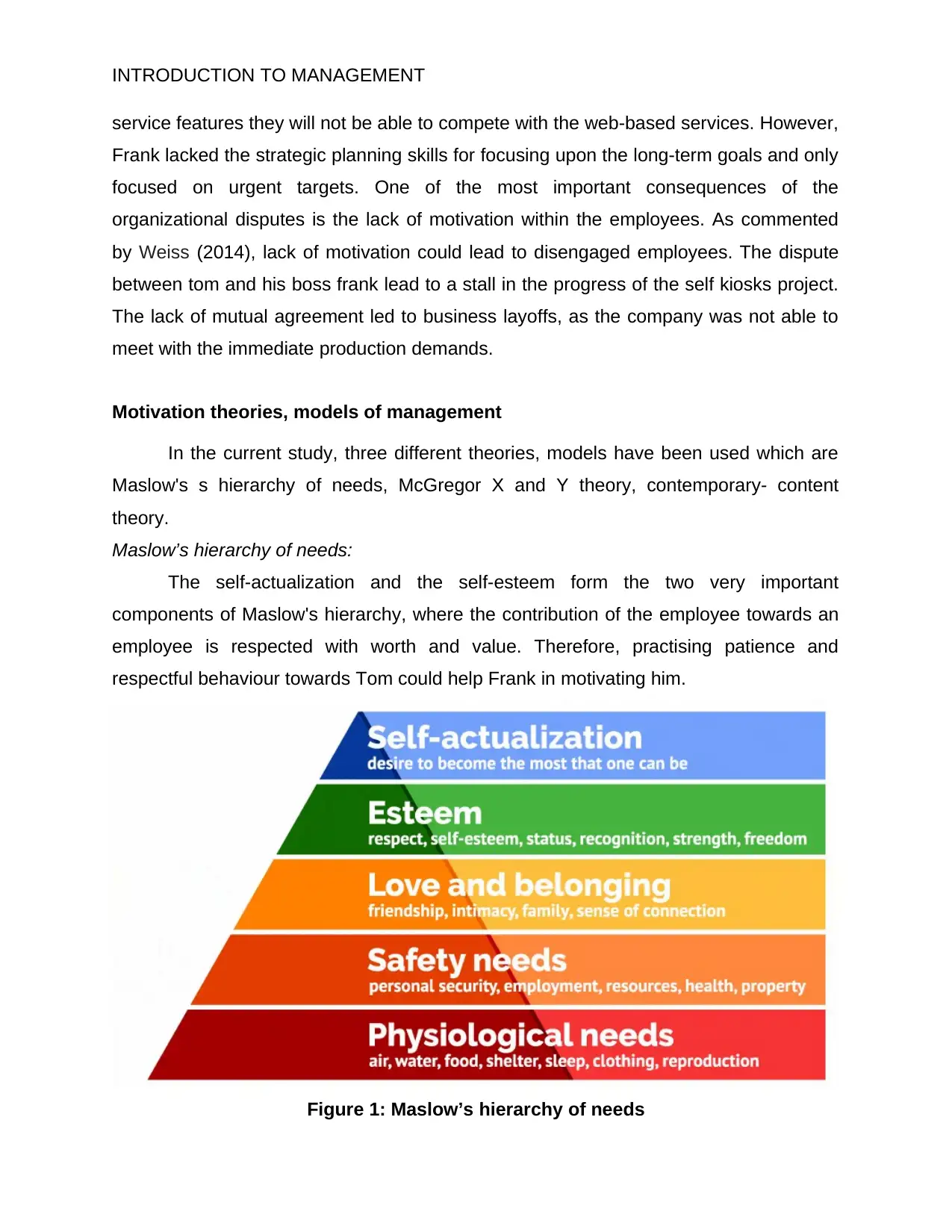
INTRODUCTION TO MANAGEMENT
service features they will not be able to compete with the web-based services. However,
Frank lacked the strategic planning skills for focusing upon the long-term goals and only
focused on urgent targets. One of the most important consequences of the
organizational disputes is the lack of motivation within the employees. As commented
by Weiss (2014), lack of motivation could lead to disengaged employees. The dispute
between tom and his boss frank lead to a stall in the progress of the self kiosks project.
The lack of mutual agreement led to business layoffs, as the company was not able to
meet with the immediate production demands.
Motivation theories, models of management
In the current study, three different theories, models have been used which are
Maslow's s hierarchy of needs, McGregor X and Y theory, contemporary- content
theory.
Maslow’s hierarchy of needs:
The self-actualization and the self-esteem form the two very important
components of Maslow's hierarchy, where the contribution of the employee towards an
employee is respected with worth and value. Therefore, practising patience and
respectful behaviour towards Tom could help Frank in motivating him.
Figure 1: Maslow’s hierarchy of needs
service features they will not be able to compete with the web-based services. However,
Frank lacked the strategic planning skills for focusing upon the long-term goals and only
focused on urgent targets. One of the most important consequences of the
organizational disputes is the lack of motivation within the employees. As commented
by Weiss (2014), lack of motivation could lead to disengaged employees. The dispute
between tom and his boss frank lead to a stall in the progress of the self kiosks project.
The lack of mutual agreement led to business layoffs, as the company was not able to
meet with the immediate production demands.
Motivation theories, models of management
In the current study, three different theories, models have been used which are
Maslow's s hierarchy of needs, McGregor X and Y theory, contemporary- content
theory.
Maslow’s hierarchy of needs:
The self-actualization and the self-esteem form the two very important
components of Maslow's hierarchy, where the contribution of the employee towards an
employee is respected with worth and value. Therefore, practising patience and
respectful behaviour towards Tom could help Frank in motivating him.
Figure 1: Maslow’s hierarchy of needs
Paraphrase This Document
Need a fresh take? Get an instant paraphrase of this document with our AI Paraphraser
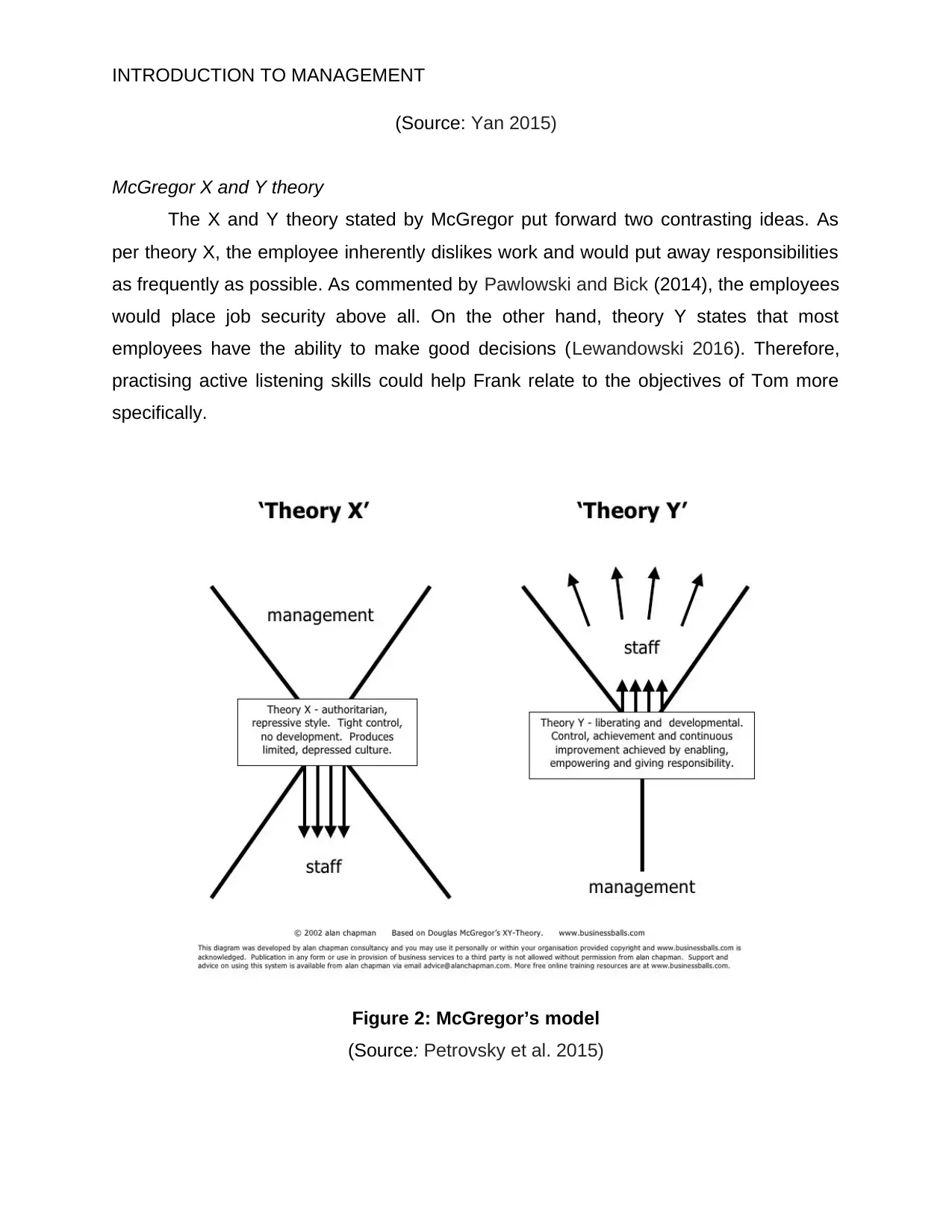
INTRODUCTION TO MANAGEMENT
(Source: Yan 2015)
McGregor X and Y theory
The X and Y theory stated by McGregor put forward two contrasting ideas. As
per theory X, the employee inherently dislikes work and would put away responsibilities
as frequently as possible. As commented by Pawlowski and Bick (2014), the employees
would place job security above all. On the other hand, theory Y states that most
employees have the ability to make good decisions (Lewandowski 2016). Therefore,
practising active listening skills could help Frank relate to the objectives of Tom more
specifically.
Figure 2: McGregor’s model
(Source: Petrovsky et al. 2015)
(Source: Yan 2015)
McGregor X and Y theory
The X and Y theory stated by McGregor put forward two contrasting ideas. As
per theory X, the employee inherently dislikes work and would put away responsibilities
as frequently as possible. As commented by Pawlowski and Bick (2014), the employees
would place job security above all. On the other hand, theory Y states that most
employees have the ability to make good decisions (Lewandowski 2016). Therefore,
practising active listening skills could help Frank relate to the objectives of Tom more
specifically.
Figure 2: McGregor’s model
(Source: Petrovsky et al. 2015)
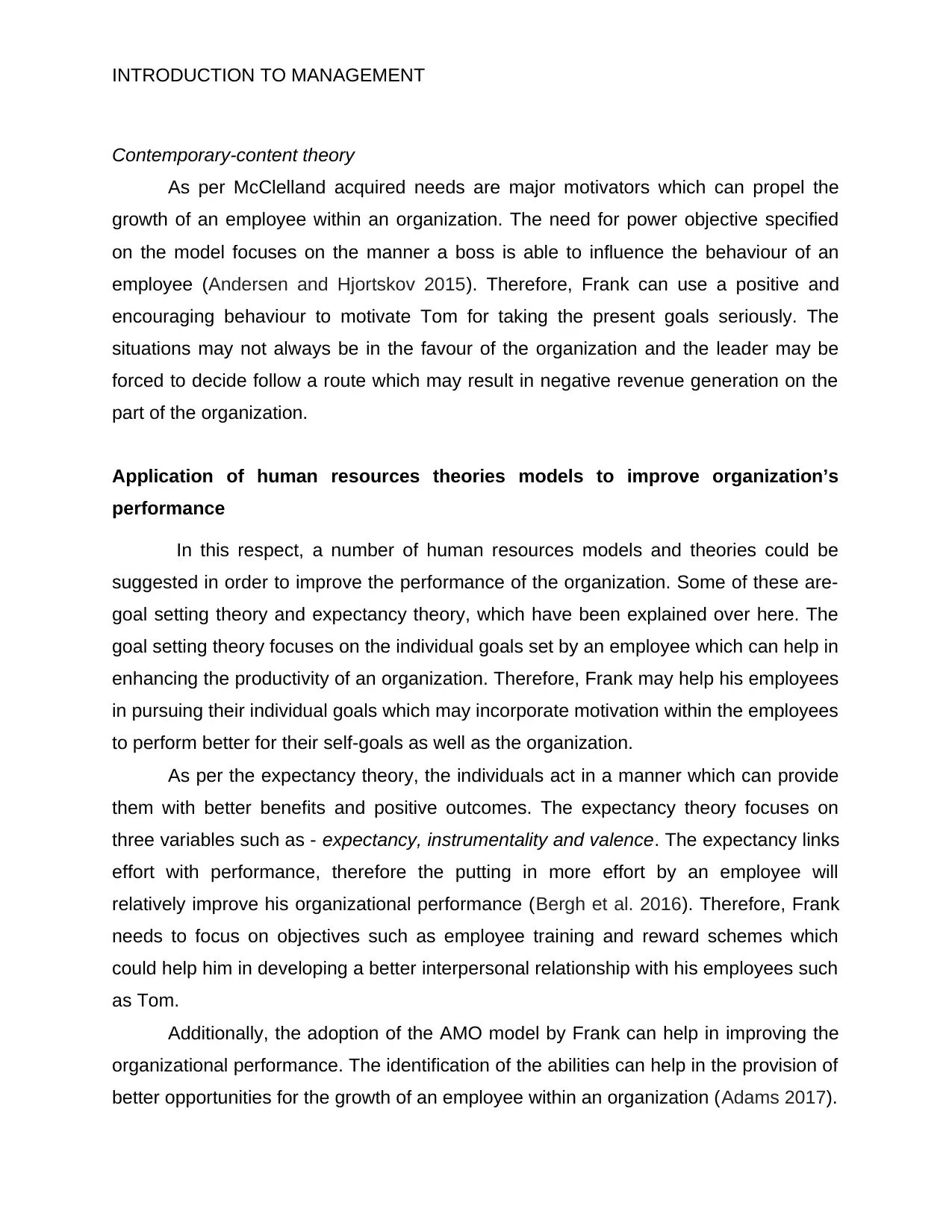
INTRODUCTION TO MANAGEMENT
Contemporary-content theory
As per McClelland acquired needs are major motivators which can propel the
growth of an employee within an organization. The need for power objective specified
on the model focuses on the manner a boss is able to influence the behaviour of an
employee (Andersen and Hjortskov 2015). Therefore, Frank can use a positive and
encouraging behaviour to motivate Tom for taking the present goals seriously. The
situations may not always be in the favour of the organization and the leader may be
forced to decide follow a route which may result in negative revenue generation on the
part of the organization.
Application of human resources theories models to improve organization’s
performance
In this respect, a number of human resources models and theories could be
suggested in order to improve the performance of the organization. Some of these are-
goal setting theory and expectancy theory, which have been explained over here. The
goal setting theory focuses on the individual goals set by an employee which can help in
enhancing the productivity of an organization. Therefore, Frank may help his employees
in pursuing their individual goals which may incorporate motivation within the employees
to perform better for their self-goals as well as the organization.
As per the expectancy theory, the individuals act in a manner which can provide
them with better benefits and positive outcomes. The expectancy theory focuses on
three variables such as - expectancy, instrumentality and valence. The expectancy links
effort with performance, therefore the putting in more effort by an employee will
relatively improve his organizational performance (Bergh et al. 2016). Therefore, Frank
needs to focus on objectives such as employee training and reward schemes which
could help him in developing a better interpersonal relationship with his employees such
as Tom.
Additionally, the adoption of the AMO model by Frank can help in improving the
organizational performance. The identification of the abilities can help in the provision of
better opportunities for the growth of an employee within an organization (Adams 2017).
Contemporary-content theory
As per McClelland acquired needs are major motivators which can propel the
growth of an employee within an organization. The need for power objective specified
on the model focuses on the manner a boss is able to influence the behaviour of an
employee (Andersen and Hjortskov 2015). Therefore, Frank can use a positive and
encouraging behaviour to motivate Tom for taking the present goals seriously. The
situations may not always be in the favour of the organization and the leader may be
forced to decide follow a route which may result in negative revenue generation on the
part of the organization.
Application of human resources theories models to improve organization’s
performance
In this respect, a number of human resources models and theories could be
suggested in order to improve the performance of the organization. Some of these are-
goal setting theory and expectancy theory, which have been explained over here. The
goal setting theory focuses on the individual goals set by an employee which can help in
enhancing the productivity of an organization. Therefore, Frank may help his employees
in pursuing their individual goals which may incorporate motivation within the employees
to perform better for their self-goals as well as the organization.
As per the expectancy theory, the individuals act in a manner which can provide
them with better benefits and positive outcomes. The expectancy theory focuses on
three variables such as - expectancy, instrumentality and valence. The expectancy links
effort with performance, therefore the putting in more effort by an employee will
relatively improve his organizational performance (Bergh et al. 2016). Therefore, Frank
needs to focus on objectives such as employee training and reward schemes which
could help him in developing a better interpersonal relationship with his employees such
as Tom.
Additionally, the adoption of the AMO model by Frank can help in improving the
organizational performance. The identification of the abilities can help in the provision of
better opportunities for the growth of an employee within an organization (Adams 2017).
⊘ This is a preview!⊘
Do you want full access?
Subscribe today to unlock all pages.

Trusted by 1+ million students worldwide
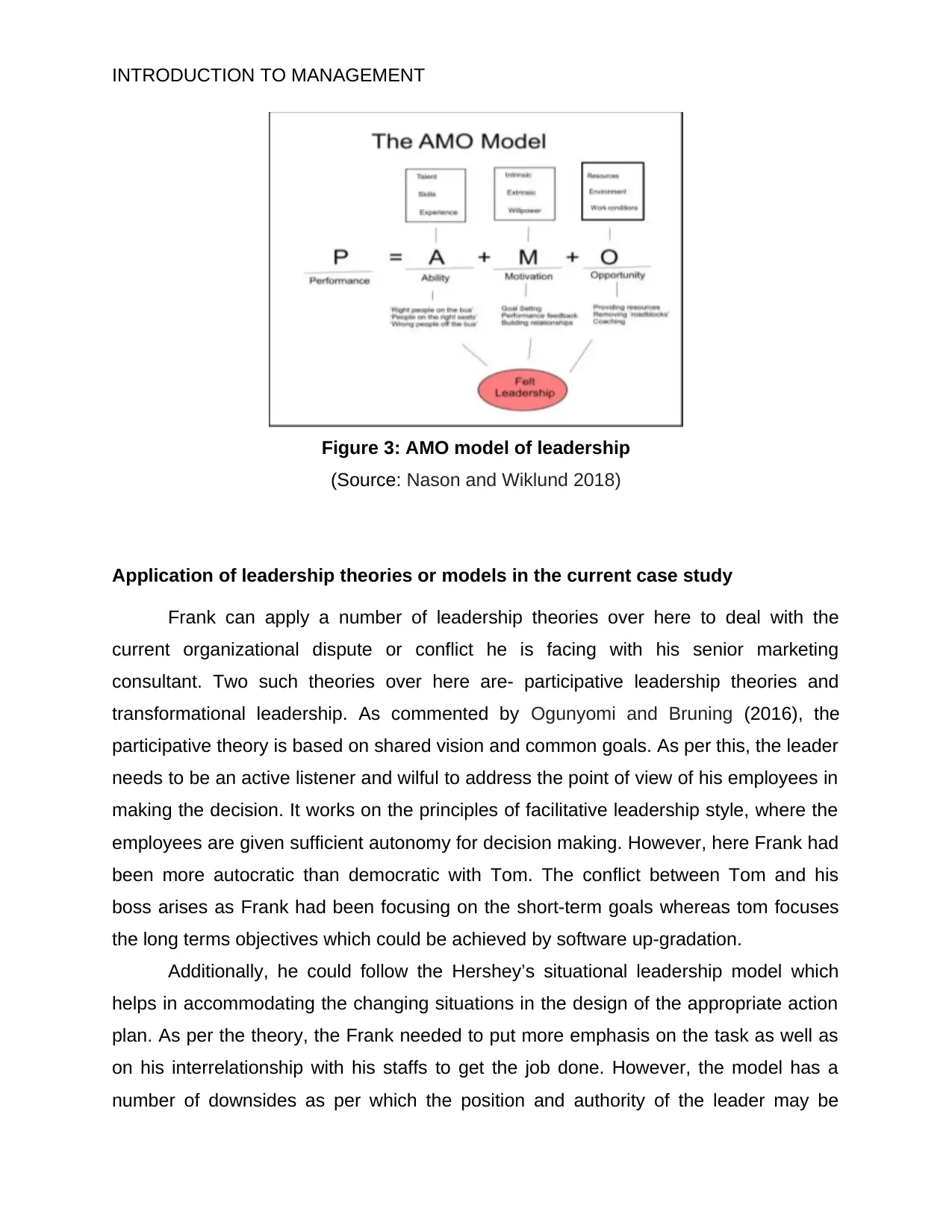
INTRODUCTION TO MANAGEMENT
Figure 3: AMO model of leadership
(Source: Nason and Wiklund 2018)
Application of leadership theories or models in the current case study
Frank can apply a number of leadership theories over here to deal with the
current organizational dispute or conflict he is facing with his senior marketing
consultant. Two such theories over here are- participative leadership theories and
transformational leadership. As commented by Ogunyomi and Bruning (2016), the
participative theory is based on shared vision and common goals. As per this, the leader
needs to be an active listener and wilful to address the point of view of his employees in
making the decision. It works on the principles of facilitative leadership style, where the
employees are given sufficient autonomy for decision making. However, here Frank had
been more autocratic than democratic with Tom. The conflict between Tom and his
boss arises as Frank had been focusing on the short-term goals whereas tom focuses
the long terms objectives which could be achieved by software up-gradation.
Additionally, he could follow the Hershey’s situational leadership model which
helps in accommodating the changing situations in the design of the appropriate action
plan. As per the theory, the Frank needed to put more emphasis on the task as well as
on his interrelationship with his staffs to get the job done. However, the model has a
number of downsides as per which the position and authority of the leader may be
Figure 3: AMO model of leadership
(Source: Nason and Wiklund 2018)
Application of leadership theories or models in the current case study
Frank can apply a number of leadership theories over here to deal with the
current organizational dispute or conflict he is facing with his senior marketing
consultant. Two such theories over here are- participative leadership theories and
transformational leadership. As commented by Ogunyomi and Bruning (2016), the
participative theory is based on shared vision and common goals. As per this, the leader
needs to be an active listener and wilful to address the point of view of his employees in
making the decision. It works on the principles of facilitative leadership style, where the
employees are given sufficient autonomy for decision making. However, here Frank had
been more autocratic than democratic with Tom. The conflict between Tom and his
boss arises as Frank had been focusing on the short-term goals whereas tom focuses
the long terms objectives which could be achieved by software up-gradation.
Additionally, he could follow the Hershey’s situational leadership model which
helps in accommodating the changing situations in the design of the appropriate action
plan. As per the theory, the Frank needed to put more emphasis on the task as well as
on his interrelationship with his staffs to get the job done. However, the model has a
number of downsides as per which the position and authority of the leader may be
Paraphrase This Document
Need a fresh take? Get an instant paraphrase of this document with our AI Paraphraser
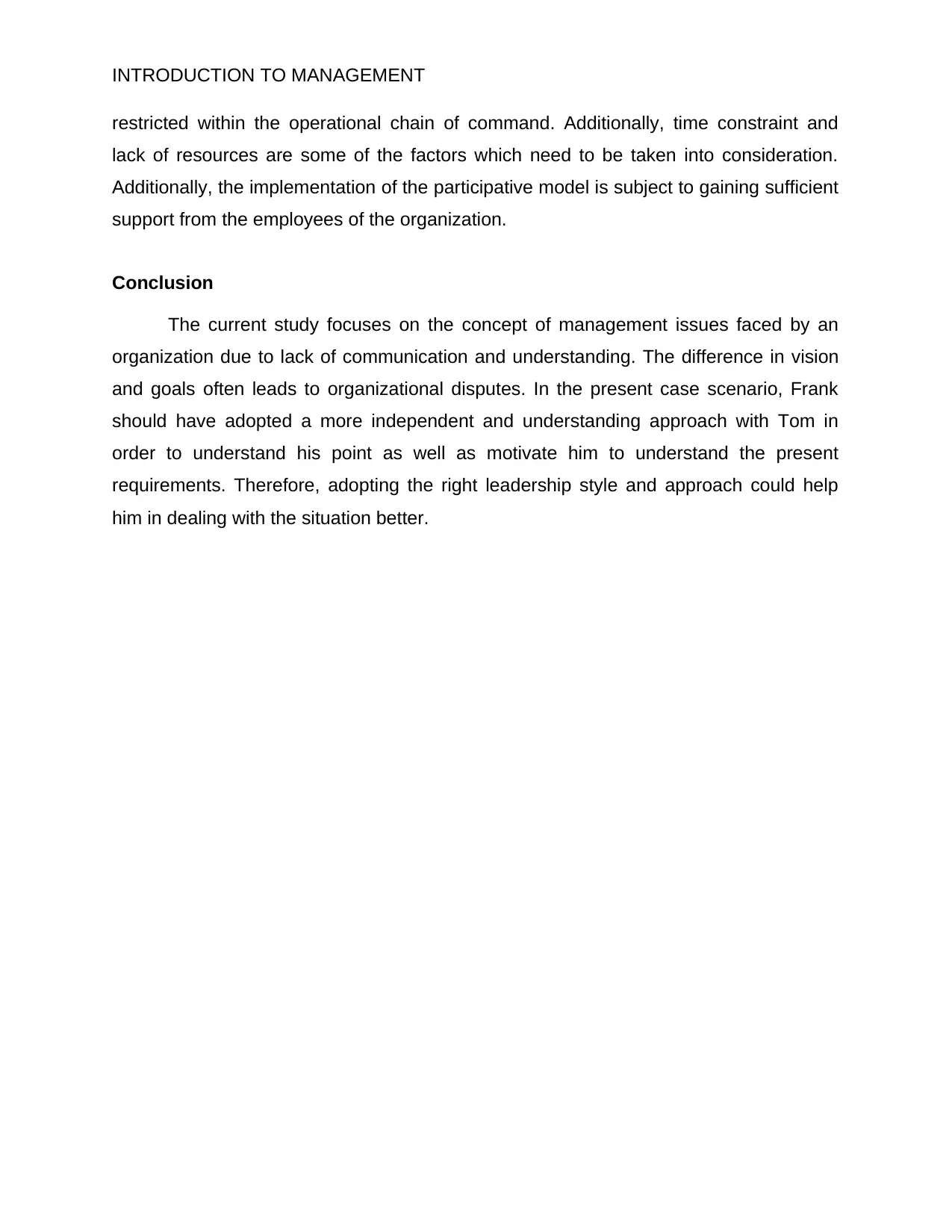
INTRODUCTION TO MANAGEMENT
restricted within the operational chain of command. Additionally, time constraint and
lack of resources are some of the factors which need to be taken into consideration.
Additionally, the implementation of the participative model is subject to gaining sufficient
support from the employees of the organization.
Conclusion
The current study focuses on the concept of management issues faced by an
organization due to lack of communication and understanding. The difference in vision
and goals often leads to organizational disputes. In the present case scenario, Frank
should have adopted a more independent and understanding approach with Tom in
order to understand his point as well as motivate him to understand the present
requirements. Therefore, adopting the right leadership style and approach could help
him in dealing with the situation better.
restricted within the operational chain of command. Additionally, time constraint and
lack of resources are some of the factors which need to be taken into consideration.
Additionally, the implementation of the participative model is subject to gaining sufficient
support from the employees of the organization.
Conclusion
The current study focuses on the concept of management issues faced by an
organization due to lack of communication and understanding. The difference in vision
and goals often leads to organizational disputes. In the present case scenario, Frank
should have adopted a more independent and understanding approach with Tom in
order to understand his point as well as motivate him to understand the present
requirements. Therefore, adopting the right leadership style and approach could help
him in dealing with the situation better.
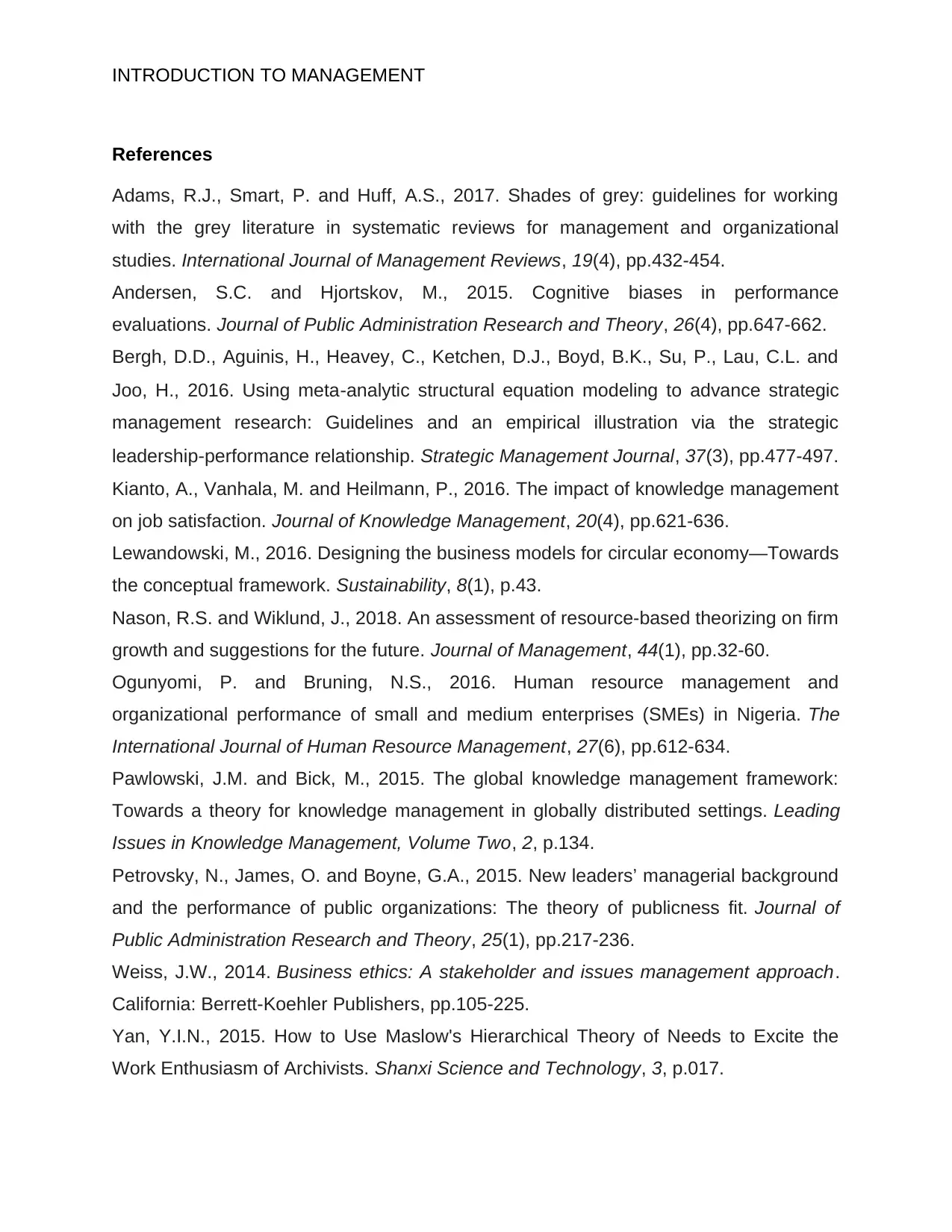
INTRODUCTION TO MANAGEMENT
References
Adams, R.J., Smart, P. and Huff, A.S., 2017. Shades of grey: guidelines for working
with the grey literature in systematic reviews for management and organizational
studies. International Journal of Management Reviews, 19(4), pp.432-454.
Andersen, S.C. and Hjortskov, M., 2015. Cognitive biases in performance
evaluations. Journal of Public Administration Research and Theory, 26(4), pp.647-662.
Bergh, D.D., Aguinis, H., Heavey, C., Ketchen, D.J., Boyd, B.K., Su, P., Lau, C.L. and
Joo, H., 2016. Using meta‐analytic structural equation modeling to advance strategic
management research: Guidelines and an empirical illustration via the strategic
leadership‐performance relationship. Strategic Management Journal, 37(3), pp.477-497.
Kianto, A., Vanhala, M. and Heilmann, P., 2016. The impact of knowledge management
on job satisfaction. Journal of Knowledge Management, 20(4), pp.621-636.
Lewandowski, M., 2016. Designing the business models for circular economy—Towards
the conceptual framework. Sustainability, 8(1), p.43.
Nason, R.S. and Wiklund, J., 2018. An assessment of resource-based theorizing on firm
growth and suggestions for the future. Journal of Management, 44(1), pp.32-60.
Ogunyomi, P. and Bruning, N.S., 2016. Human resource management and
organizational performance of small and medium enterprises (SMEs) in Nigeria. The
International Journal of Human Resource Management, 27(6), pp.612-634.
Pawlowski, J.M. and Bick, M., 2015. The global knowledge management framework:
Towards a theory for knowledge management in globally distributed settings. Leading
Issues in Knowledge Management, Volume Two, 2, p.134.
Petrovsky, N., James, O. and Boyne, G.A., 2015. New leaders’ managerial background
and the performance of public organizations: The theory of publicness fit. Journal of
Public Administration Research and Theory, 25(1), pp.217-236.
Weiss, J.W., 2014. Business ethics: A stakeholder and issues management approach.
California: Berrett-Koehler Publishers, pp.105-225.
Yan, Y.I.N., 2015. How to Use Maslow's Hierarchical Theory of Needs to Excite the
Work Enthusiasm of Archivists. Shanxi Science and Technology, 3, p.017.
References
Adams, R.J., Smart, P. and Huff, A.S., 2017. Shades of grey: guidelines for working
with the grey literature in systematic reviews for management and organizational
studies. International Journal of Management Reviews, 19(4), pp.432-454.
Andersen, S.C. and Hjortskov, M., 2015. Cognitive biases in performance
evaluations. Journal of Public Administration Research and Theory, 26(4), pp.647-662.
Bergh, D.D., Aguinis, H., Heavey, C., Ketchen, D.J., Boyd, B.K., Su, P., Lau, C.L. and
Joo, H., 2016. Using meta‐analytic structural equation modeling to advance strategic
management research: Guidelines and an empirical illustration via the strategic
leadership‐performance relationship. Strategic Management Journal, 37(3), pp.477-497.
Kianto, A., Vanhala, M. and Heilmann, P., 2016. The impact of knowledge management
on job satisfaction. Journal of Knowledge Management, 20(4), pp.621-636.
Lewandowski, M., 2016. Designing the business models for circular economy—Towards
the conceptual framework. Sustainability, 8(1), p.43.
Nason, R.S. and Wiklund, J., 2018. An assessment of resource-based theorizing on firm
growth and suggestions for the future. Journal of Management, 44(1), pp.32-60.
Ogunyomi, P. and Bruning, N.S., 2016. Human resource management and
organizational performance of small and medium enterprises (SMEs) in Nigeria. The
International Journal of Human Resource Management, 27(6), pp.612-634.
Pawlowski, J.M. and Bick, M., 2015. The global knowledge management framework:
Towards a theory for knowledge management in globally distributed settings. Leading
Issues in Knowledge Management, Volume Two, 2, p.134.
Petrovsky, N., James, O. and Boyne, G.A., 2015. New leaders’ managerial background
and the performance of public organizations: The theory of publicness fit. Journal of
Public Administration Research and Theory, 25(1), pp.217-236.
Weiss, J.W., 2014. Business ethics: A stakeholder and issues management approach.
California: Berrett-Koehler Publishers, pp.105-225.
Yan, Y.I.N., 2015. How to Use Maslow's Hierarchical Theory of Needs to Excite the
Work Enthusiasm of Archivists. Shanxi Science and Technology, 3, p.017.
⊘ This is a preview!⊘
Do you want full access?
Subscribe today to unlock all pages.

Trusted by 1+ million students worldwide
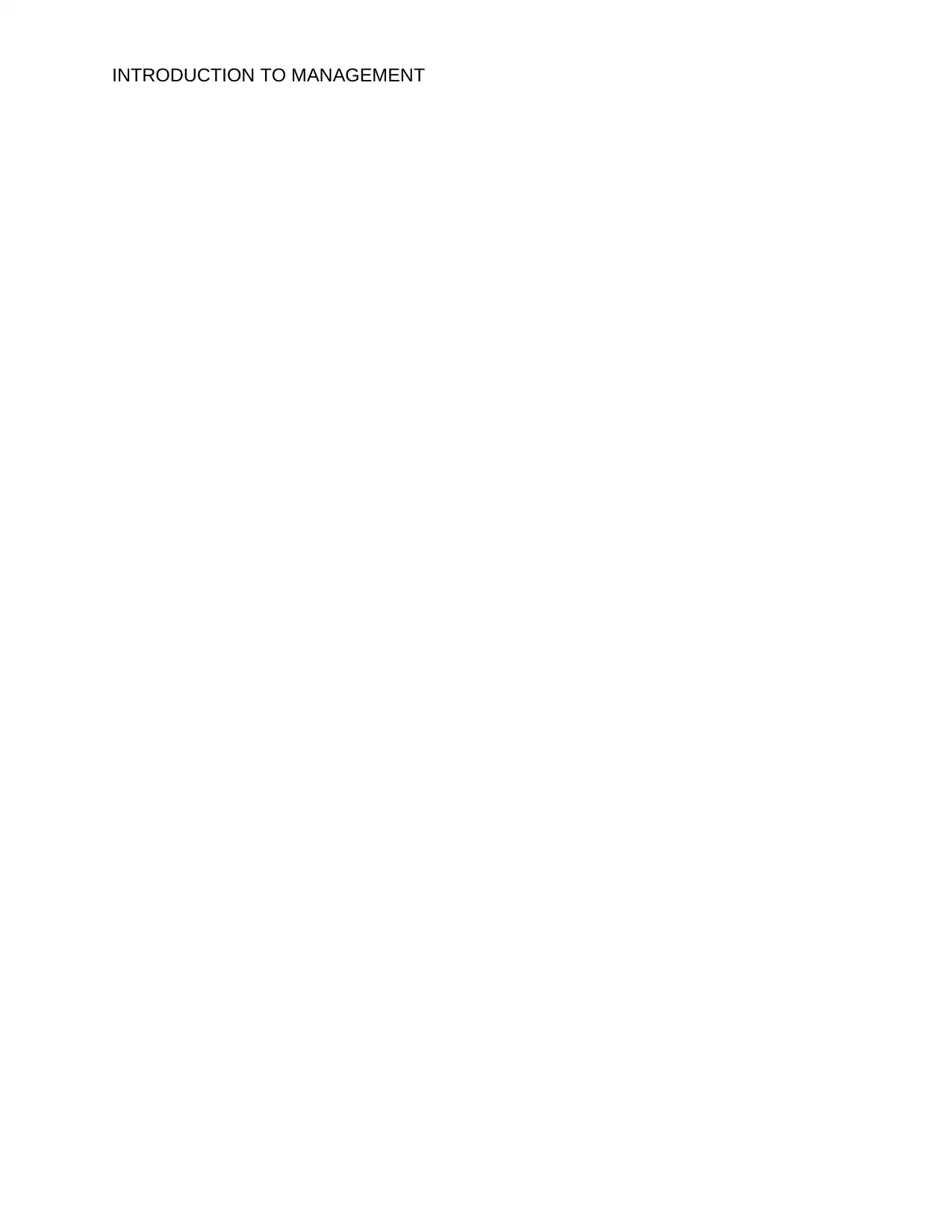
INTRODUCTION TO MANAGEMENT
1 out of 10
Related Documents
Your All-in-One AI-Powered Toolkit for Academic Success.
+13062052269
info@desklib.com
Available 24*7 on WhatsApp / Email
![[object Object]](/_next/static/media/star-bottom.7253800d.svg)
Unlock your academic potential
Copyright © 2020–2025 A2Z Services. All Rights Reserved. Developed and managed by ZUCOL.





